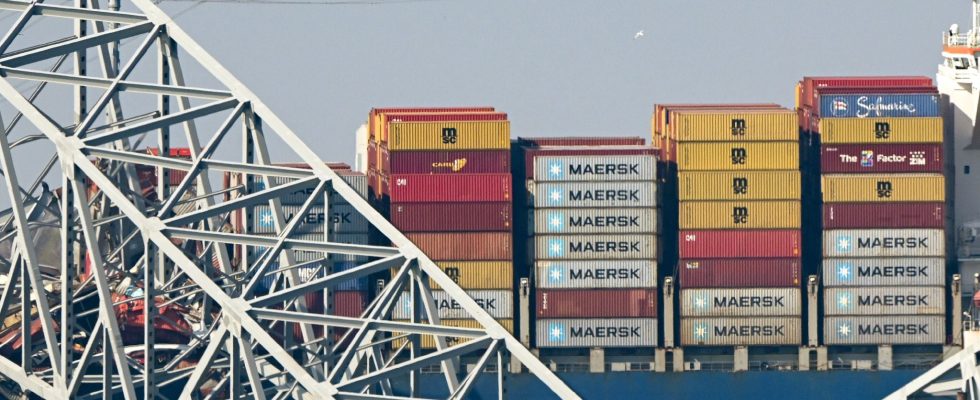After the tragedy in Baltimore (United States) during which a bridge hit by a cargo ship collapsed on the night of March 25 to 26, killing six workers who were working on the structure, the time has come to begin repairs and costing of damage. It could be the highest compensation ever paid by marine insurance companies, opening a legal battle.
According to Bruce Carnegie-Brown, the head of the Lloyd’s of London insurance market interviewed by AFP, while it is “too early to give an estimate”, the damage should “represent a substantial loss, undoubtedly the largest ” of the history of maritime transport. Among the reasons given: “the shutdown of many companies, of certain supply chains due to ships blocked at the same time in the port and which will not be able to reach it, and the second-order effects”, concerning of course the ship in itself, its cargo and the deck. For an analyst interviewed by Reuters, these costs could reach up to $4 billion. And thus surpass the record losses during the Costa Concordia accident in 2012.
Tedious clearing
The priority is to clear the area. The port of Baltimore, on the east coast of the United States, is still blocked, with a considerable economic impact on the “8,000 dockworkers” whose “work has been directly affected”, according to the governor. “We need to clear the channel and open shipping traffic to the port. Because the health of Maryland’s economy and the national economy depends on it,” Wes Moore said during a press briefing.
Clearing the ruins of the immense Francis Scott Key Bridge began this Saturday, March 30. The process promises to be colossal, the emergency services having to first cut the bridge “of 3,000 to 4,000 tonnes” in order to extract the pieces using a crane, the Chesapeake – belonging to the French Navy – capable of lift 1,000 tons. “In the coming weeks, we expect the following entities to be on the water: seven floating cranes, ten tugboats, nine barges, eight rescue vessels and five coast guard boats,” detailed the governor of Mayland.
“We will not be able to rebuild the bridge until we have” cleared the debris, insisted Wes Moore. This reconstruction “is not going to take hours, nor days, nor weeks,” he warned. After the tragedy, Joe Biden pledged that the federal administration would cover the entire cost of reconstruction. According to economic software analysis company IMPLAN, the work could cost around $600 million, it told Reuters.
Port economy
If the Port of Baltimore is rather a second-tier American port (only 2.1% of container imports pass through it), it remains important for certain sectors of the economy, such as the automobile – it is the one through which transit the most new cars, more than 800,000 last year – but also for the transit of aluminum, copper and even coal, according to the S&P agency.
Closing the port for just one month could result in a total loss of $28 million to the state of Maryland, according to IMPLAN’s analysis. “The White House and federal agencies are actively engaged to minimize interruptions to maritime deliveries, which are diverted as long as the Port of Baltimore remains closed,” the presidency said in a statement. Maryland, where Baltimore is located, asked the federal state for an initial envelope of $60 million, an appeal quickly heard by the government.
Legal battle
The Dali, a container ship 300 meters long – the height of the Eiffel Tower – and 48 meters wide, came crashing into a pier of the bridge, due to propulsion problems. The collision took place around 1:30 a.m. on the night of March 25 to 26, after the crew raised the alert, giving the authorities time to close all traffic lanes on the structure but without success. to avoid impact. The preliminary investigation shows that it was an accident, according to the authorities.
According to Lawrence Brennan, professor of law at Fordham University in New York, cited by the Wall Street Journal, it will likely be “one of the most contentious marine insurance legal battles in decades.” Grace Ocean, the Singaporean company that owns the Dali, is likely to “invoke a law dating from the 19th century which caps the liability of ship owners”, at the value of the ship and the goods it was carrying at the time of the accident . The same law used by the owners of the Titanic at the time.
Compensation should, however, not be the responsibility of “a single insurer”, Brandon Holmes, analyst for Moody’s, told AFP, as the risk is “shared by many companies” in order to limit its impact. Around 80 different insurance companies cover Grace Ocean’s direct insurance, which limits damage costs on an individual scale.
The disaster killed six workers who were working on the bridge at the time of the accident, all Latin American immigrants. The bodies of two of them, aged 35 and 26, were found, while the other four workers were declared dead. Operations to find the remains are still interrupted, because the authorities currently consider the work of divers at the accident site too dangerous. Baltimore City Hall has launched a fundraiser to support the victims’ families.
